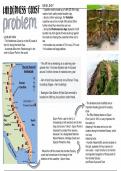Summary
Summary Cambridge International AS and A Level Geography second edition - Coastal management case study
- Module
- Coastal landforms
- Institution
- CIE
An in depth summary of A2 Cambridge International A level Geography, notes on a case study regarding the Holderness coast
[Show more]



